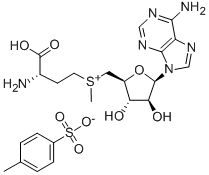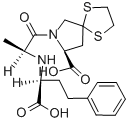L-ETHIONINE
Synonym(s):L -2-Amino-4-(ethylthio)butyric acid
- CAS NO.:13073-35-3
- Empirical Formula: C6H13NO2S
- Molecular Weight: 163.24
- MDL number: MFCD00002626
- EINECS: 235-966-4
- SAFETY DATA SHEET (SDS)
- Update Date: 2024-12-18 14:15:30

What is L-ETHIONINE?
Chemical properties
White Solid
The Uses of L-ETHIONINE
Ethionine-induced inhibition of protein synthesis and lowering of ATP level in the liver.
Definition
ChEBI: An S-ethylhomocysteine that has S-configuration at the chiral centre.
Purification Methods
Likely impurities are N-acetyl-(R and S)-ethionine, S-methionine, and R-ethionine. Crystallise it from water by adding 4volumes of EtOH or 85% aqueous EtOH. It sublimes at 196-216o/0.3mm with 99.1% recovery and unracemised [Gross & Gradsky J Am Chem Soc 77 1678 1955]. [Weiss & Stekol J Am Chem Soc 73 2399 1951, Greenstein & Winitz The Chemistry of the Amino Acids J. Wiley, Vol 3 pp 2658, 2659 1961, Beilstein 4 IV 3194.]
Properties of L-ETHIONINE
| Melting point: | 280 °C (dec.)(lit.) |
| alpha | D24 +25.1°; D23 +20.1° (1N HCl) (Armstrong, Lewis) |
| Density | 1.085 (estimate) |
| refractive index | 22 ° (C=1, 1mol/L HCl) |
| storage temp. | Keep in dark place,Sealed in dry,2-8°C |
| solubility | Aqueous Acid (Slightly), Water (Slightly) |
| form | solid |
| Boiling point: | 310.4±37.0 °C(Predicted) |
| pka | 2.23±0.10(Predicted) |
| color | White to Off-White |
| Merck | 14,3738 |
| CAS DataBase Reference | 13073-35-3(CAS DataBase Reference) |
| EPA Substance Registry System | L-Ethionine (13073-35-3) |
Safety information for L-ETHIONINE
| Signal word | Warning |
| Pictogram(s) |
 Exclamation Mark Irritant GHS07 |
| GHS Hazard Statements |
H315:Skin corrosion/irritation H319:Serious eye damage/eye irritation H335:Specific target organ toxicity, single exposure;Respiratory tract irritation |
| Precautionary Statement Codes |
P261:Avoid breathing dust/fume/gas/mist/vapours/spray. P264:Wash hands thoroughly after handling. P264:Wash skin thouroughly after handling. P271:Use only outdoors or in a well-ventilated area. P280:Wear protective gloves/protective clothing/eye protection/face protection. P302+P352:IF ON SKIN: wash with plenty of soap and water. P305+P351+P338:IF IN EYES: Rinse cautiously with water for several minutes. Remove contact lenses, if present and easy to do. Continuerinsing. |
Computed Descriptors for L-ETHIONINE
New Products
(S)-3-Aminobutanenitrile hydrochloride 4-Methylphenylacetic acid N-Boc-D-alaninol N-BOC-D/L-ALANINOL Tert-butyl bis(2-chloroethyl)carbamate 3-Morpholino-1-(4-nitrophenyl)-5,6-dihydropyridin- 2(1H)-one Furan-2,5-Dicarboxylic Acid Tropic acid 1-Bromo-3,5-Di-Tert-Butylbenzene S-2-CHLORO PROPIONIC ACID ETHYL ISOCYANOACETATE 2-Bromo-1,3-Bis(Dimethylamino)Trimethinium Hexafluorophosphate 4-IODO BENZOIC ACID 3-NITRO-2-METHYL ANILINE 1-(2,4-DICHLOROPHENYL) ETHANAMINE (2-Hydroxyphenyl)acetonitrile 4-Bromopyrazole 2-(Cyanocyclohexyl)acetic acid 4-methoxy-3,5-dinitropyridine 1-(4-(aminomethyl)benzyl)urea hydrochloride 2-aminopropyl benzoate hydrochloride diethyl 2-(2-((tertbutoxycarbonyl)amino) ethyl)malonate tert-butyl 4- (ureidomethyl)benzylcarbamate Ethyl-2-chloro((4-methoxyphenyl)hydrazono)acetateRelated products of tetrahydrofuran
![S-ADENOSYL-L-[METHYL-3H]METHIONINE](https://img.chemicalbook.in/CAS/GIF/111093-45-9.gif)




![S-ADENOSYL-L-METHIONINE, [METHYL-14C]](https://img.chemicalbook.in/CAS/GIF/4989-98-4.gif)


You may like
-
 L-Ethionine CAS 13073-35-3View Details
L-Ethionine CAS 13073-35-3View Details
13073-35-3 -
 L-Ethionine CAS 13073-35-3View Details
L-Ethionine CAS 13073-35-3View Details
13073-35-3 -
 1975-50-4 98%View Details
1975-50-4 98%View Details
1975-50-4 -
 2-HYDROXY BENZYL ALCOHOL 98%View Details
2-HYDROXY BENZYL ALCOHOL 98%View Details
90-01-7 -
 2-Chloro-1,3-Bis(Dimethylamino)Trimethinium Hexafluorophosphate 221615-75-4 98%View Details
2-Chloro-1,3-Bis(Dimethylamino)Trimethinium Hexafluorophosphate 221615-75-4 98%View Details
221615-75-4 -
 61397-56-6 CIS BROMO BENZOATE 98%View Details
61397-56-6 CIS BROMO BENZOATE 98%View Details
61397-56-6 -
 14714-50-2 (2-Hydroxyphenyl)acetonitrile 98+View Details
14714-50-2 (2-Hydroxyphenyl)acetonitrile 98+View Details
14714-50-2 -
 118753-70-1 98+View Details
118753-70-1 98+View Details
118753-70-1
Statement: All products displayed on this website are only used for non medical purposes such as industrial applications or scientific research, and cannot be used for clinical diagnosis or treatment of humans or animals. They are not medicinal or edible.